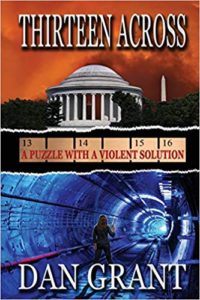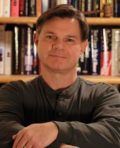Title: Thirteen Across
Author: Dan Grant
Publisher: Thriller
ISBN: 978-1-7325040-5-9
Genre: Thriller
Pages: 411
Interviewed by: Ella Vincent
Hollywood Book Reviews
Dan Grant interview questions
HBR: Thirteen Across is intriguing because of the crossword puzzle clues throughout the novel. What sparked your interest in crossword puzzles?I’ve always enjoyed solving puzzles. As an engineer, before becoming an author, part of my job was solving engineering-style problems.
The idea for the crossword puzzle in Thirteen Across came from the graphics used in Michael Crichton’s Jurassic Park. In early drafts, I noticed that a few authors of traditional mysteries included puzzles but not to the extent that I was undertaking. No one had intertwined crosswords into the fabric of a fast-paced thriller and worked with it on deeper levels (a puzzle inside a puzzle).
Knowing how many people worldwide work crossword puzzles, I researched puzzle history and lore first, and then reached out to the recognized expert in the field, The New York Times Crossword Puzzle Editor Will Shortz. Through our conversations, I mentioned that the subject matter expert in Thirteen Across could be real. So I asked him if I could fictionalize him as a support character and he said yes. I had fun writing about a real person and finding ways to have that character contribute in a meaningful way. And the puzzle had to be revealed in such a way as to not let Will solve too many answers in advance.
In terms of the puzzle’s answers, I knew that they must bond the villain and the heroine together, along with feed sub-plots and reveal non-touristy destinations.
HBR: Kate Morgan is a powerful protagonist as an FBI agent. How long did it take you to conduct research on the FBI and other government agencies in Thirteen Across?
Kate was a co-hero in my debut thriller The Singularity Witness. When I was writing Thirteen Across I knew that I needed to focus on her as the central character. I wanted a female lead that wasn’t like the portrayal of most female characters. Kate’s vulnerable yet strong when needed. She’s not a commando fighter and solves her problems using her whit, smarts and instincts. She’s lives by a strong sense of ethics but can be a rebel at times and break a few rules.
Over the years, I’ve met several FBI Special Agents. Each time they’ve been supportive in providing insight and guidance. The FBI’s Office of Public Affairs answered specific questions about internal processes, programs, and organizational structures. The FBI was tremendously generous with their time and the information provided helps build a more realistic story.
My storytelling style is research-based thrillers. I love learning about people, places, science, medicine, and technology. When possible, I visit the story locations so I can walk in the footprints of the characters. If readers what to know more behind the scenes information, a web-link is provided in the back of each book.
HBR: Phillip Barnes is a nefarious antagonist? How did you create such a malicious villain for the novel?
As a character, Barnes needed several rewrites, changing him from the everyday serial killer seen in most stories to a bit of an enigma. He’s super-intelligent, complex, and deadly. His value system is fractured. He blames many for his slights (from Kate who murdered his family, to an ex-lover, to covert researchers). Without giving too much away, I wanted Barnes disenfranchised, a man out of place and time and with a broken heart. His existence needed to be tied to an aspect of research as well. Barnes wants to destroy those that made him into who he had become, but in a way that doesn’t allow the government to sweep transcendent secrets (its dirty laundry) under the rug. Barnes thinks on a grand scale and has planned out his revenge years in advance.
HBR: Which writers influenced your writing?
Wow, there’s too many to name (and I’m going to miss a few). The Singularity Witness (my debut thriller) was influenced by the works from Steve Berry, Michael Crichton, and Robin Cook. Thirteen Across is a faster-paced thriller, similar to the works by Dan Brown and James Patterson. Other early influencers were John Grisham and Tom Clancy.
HBR: What do you want readers to get from reading Thirteen Across?
My desire is tell stories that pose deeper questions. I want readers to think and learn about an aspect of science, medicine, technology, or history (in a fun way). What’s real? What’s fiction? Could this or that really happen? I want to write intricate stories that have sub-layers and introduce characters that are not cookie cutter cutouts. In the end was the story fun, different enough, and a good page-turner?
HBR: Do you plan on writing more books?
I’m now writing The Singularity Transfer (a sequel to my debut science/medical thriller) which will again feature neuroscientist and university professor Thomas Parker and FBI Special Agent Kate Morgan. Kate will return in an untitled sequel to Thirteen Across. Both story series will share characters between story worlds and there may be a few spinoffs with secondary characters in the works as well.


